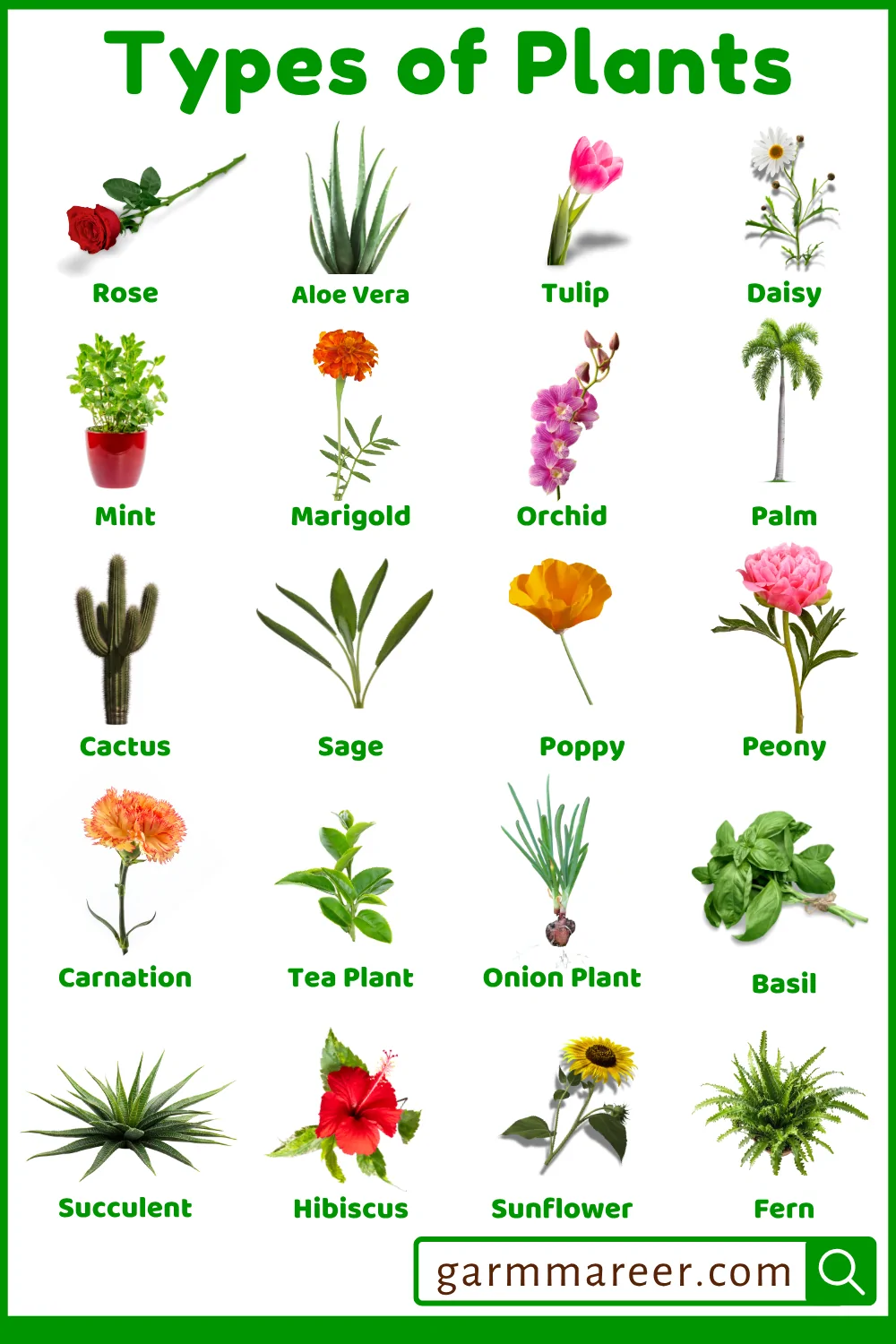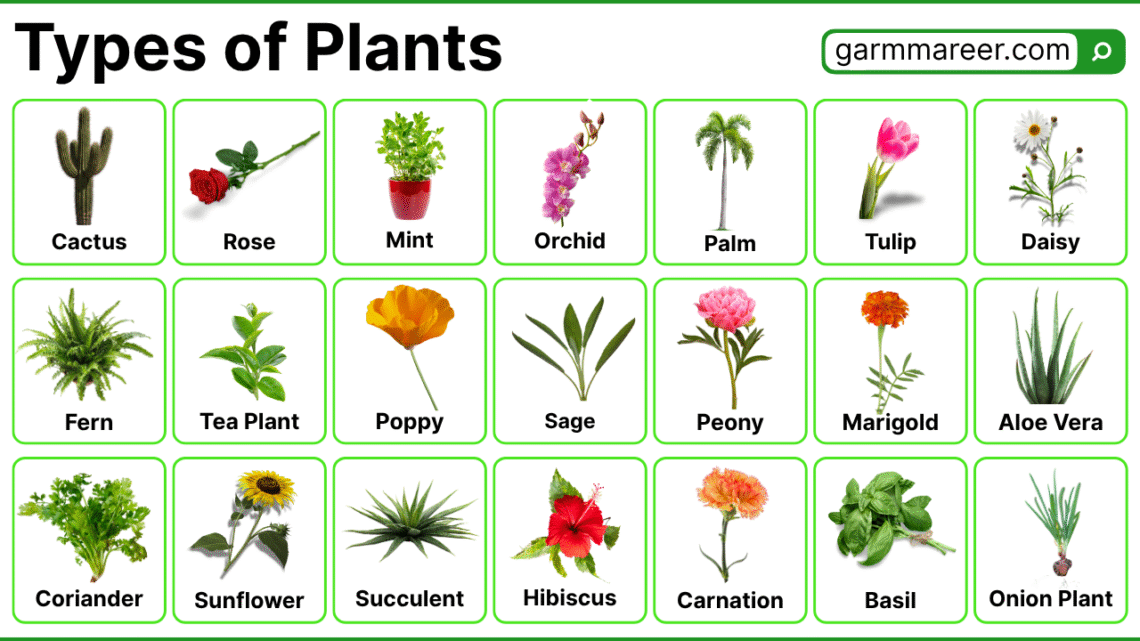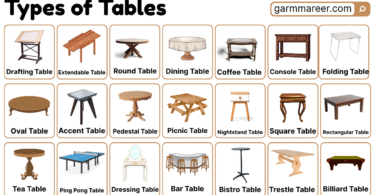Plants are a very important part of our lives. They provide us with food, oxygen, medicine, and beauty. Learning plant names in English helps students and learners recognize them easily in daily life. This blog post will help you learn different types of plants, their names, interesting facts, and their uses along with pictures.
Table of Contents
Plants Names in English with Pictures
- Rose
- Sunflower
- Tulip
- Mango tree
- Banana plant
- Coconut tree
- Neem tree
- Bamboo
- Cactus
- Aloe Vera
- Lavender
- Mint
- Basil
- Jasmine
- Lily
- Orchid
- Peepal tree
- Banyan tree
- Apple tree
- Grapevine
- Orange tree
- Papaya plant
- Guava tree
- Lemon tree
- Tea plant
- Coffee plant
- Rice plant
- Wheat plant
- Corn plant
- Barley plant
- Spinach
- Potato plant
- Tomato plant
- Ginger
- Garlic
- Onion
- Mustard plant
- Cotton plant
- Rubber plant
- Tulsi
- Hibiscus
- Pomegranate tree
- Peach tree
- Cherry tree
- Plum tree
- Pine tree
- Oak tree
- Maple tree
- Fern
- Mushroom
- Moss

Types of Plants Names
Types of plants include trees, shrubs, herbs, climbers, and creepers. Example: A mango tree gives fruit, while a rose shrub blooms beautifully.
Annual Plants Names
Annual plants live for only one season. They grow, flower, and die within a year.
- Marigold – Bright flowers grown in gardens.
- Zinnia – Colorful summer blooming flowers.
- Sunflower – Tall plant with large yellow flowers.
- Petunia – Popular bedding flowers.
- Corn – Grain crop grown for food.
- Wheat – Common cereal for flour.
- Rice – Staple food in many countries.
- Tomato – Edible fruiting plant.
- Cucumber – Summer vegetable plant.
- Mustard – Oilseed and spice plant.
Biennial Plants and Their Features
Biennial plants take two years to complete their life cycle.
- Carrot – First year root growth, second year flowers.
- Beetroot – Edible root in the first year.
- Onion – Bulb plant growing in two years.
- Cabbage – Leafy vegetable, biennial in nature.
- Celery – Stalk eaten in the first year.
- Parsley – Herb with biennial life span.
Perennial Plants Found in Nature
Perennial plants live for many years and bloom again and again.
- Mango tree – Fruit tree living for decades.
- Banana plant – Perennial producing fruits.
- Rose – Popular ornamental flower.
- Tulsi – Sacred plant in homes.
- Aloe Vera – Medicinal succulent.
- Neem tree – Strong medicinal tree.
- Guava tree – Fruit-bearing perennial.
- Hibiscus – Garden flowering plant.
- Lavender – Fragrant flowering herb.
- Coconut tree – Tall palm with fruits.
Types of Plants by Habitat
| Aquatic Plants | Terrestrial Plants | Desert Plants | Alpine Plants |
|---|---|---|---|
| Lotus | Mango tree | Cactus | Edelweiss |
| Water Lily | Rose | Aloe Vera | Alpine Forget-me-not |
| Hydrilla | Neem | Date Palm | Moss Campion |
| Duckweed | Banyan tree | Agave | Alpine Poppy |
| Tape grass | Oak | Yucca | Snow Gentian |
Types of Plants by Use for Humans
Food-Producing Plants
- Rice
- Wheat
- Corn
- Apple tree
- Mango tree
Medicinal Plants in Daily Use
- Aloe Vera: Used for skin and health.
- Neem: Known for antibacterial properties.
- Tulsi: Used for cough and cold.
- Ginger: Relief in digestion and cold.
- Garlic: Good for heart health.
- Mint: Helps in freshness and digestion.
Ornamental Plants for Decoration
- Rose
- Orchid
- Tulip
- Sunflower
- Marigold
Industrial Plants for Products
- Cotton: For making cloth.
- Rubber: For making tires.
- Jute: Used for ropes and bags.
- Bamboo: Used in paper and furniture.
- Tea: For beverages.
Plants by Reproduction
Flowering Plants
Flowering plants, also called angiosperms, are the largest group of plants on Earth. They produce flowers for reproduction, which later turn into fruits containing seeds. These plants are common in gardens, farms, and natural habitats.
- Rose – Grown for its colorful and fragrant flowers.
- Sunflower – Produces large yellow flowers and edible seeds.
- Mango tree – Fruit-bearing tree with seasonal flowers.
- Apple tree – Produces sweet edible fruits.
- Hibiscus – Known for big red flowers and beauty.
- Tulip – Bright spring flower grown in gardens.
- Jasmine – Fragrant flowering shrub.
- Marigold – Common annual flower in gardens.
- Orchid – Exotic flowering plant with unique shapes.
- Lotus – Aquatic flowering plant, national flower of India.
- Lily – Beautiful flowering plant used in decoration.
- Peach tree – Fruit tree with pink spring flowers.
- Cherry tree – Produces blossoms and edible cherries.
- Grapevine – Produces flowers and fruits used as grapes.
- Guava tree – Flowering tree with edible fruits.
- Papaya plant – Produces flowers leading to fruits.
- Banana plant – Flowers develop into banana fruits.
- Pomegranate tree – Known for red flowers and fruit.
- Coconut tree – Tall palm producing coconuts.
- Tea plant – Flowering shrub used for tea leaves.
Non-Flowering Plants
Non-flowering plants, also called gymnosperms, bryophytes, and pteridophytes, do not produce flowers. They reproduce using spores or cones instead of seeds within fruits. These plants are often found in moist, shaded, or specialized environments.
- Fern – Reproduces through spores on leaf undersides.
- Moss – Small green plant found in damp areas.
- Mushroom – A fungus reproducing by spores.
- Algae – Aquatic plants without flowers or seeds.
- Conifers – Trees like pine and fir producing cones.
- Pine tree – Non-flowering plant with needle-like leaves.
- Cycads – Ancient non-flowering plants with cone-like structures.
- Ginkgo biloba – Known as a living fossil plant.
- Club moss – Primitive non-flowering plant in moist habitats.
- Horsetail – Reproduces with spores, not flowers.
- Liverworts – Found in moist shaded areas, reproduce with spores.
- Hornworts – Small spore-producing plants.
- Red algae – Marine algae used in food products.
- Brown algae – Seaweed like kelp, reproduces without flowers.
- Green algae – Microscopic or macroscopic non-flowering plants.
- Yeast – Microscopic fungus, reproduces by budding.
- Lichen – Combination of algae and fungi.
- Spruce tree – Conifer with cones for reproduction.
- Fir tree – Evergreen conifer without flowers.
- Cedar tree – Non-flowering conifer with woody cones.
Plants by Season
Summer Season Plants
- Sunflower: Bright summer flower.
- Tomato: Summer vegetable.
- Mango tree: Gives summer fruits.
- Watermelon: Refreshing fruit.
- Corn: Summer cereal crop.
Winter Season Plants
- Cabbage: Grows in cool season.
- Cauliflower: Winter vegetable.
- Carrot: Sweet root vegetable.
- Spinach: Leafy winter crop.
- Mustard: Winter oilseed plant.
Spring Season Plants
- Tulip: Beautiful spring flower.
- Daisy: Common spring garden plant.
- Marigold: Blooms in spring.
- Lily: Spring flowering plant.
- Rose: Spring ornamental plant.
FAQs about Types of Plants
The main types are annuals, biennials, and perennials. Each has a different life cycle.
Examples include rose, sunflower, hibiscus, mango, and apple.
Aloe Vera, neem, tulsi, ginger, and garlic are common medicinal plants.
Cactus, aloe vera, and date palm are common desert plants.
Cotton, rubber, jute, bamboo, and tea are used in various products.
You May Also Like




